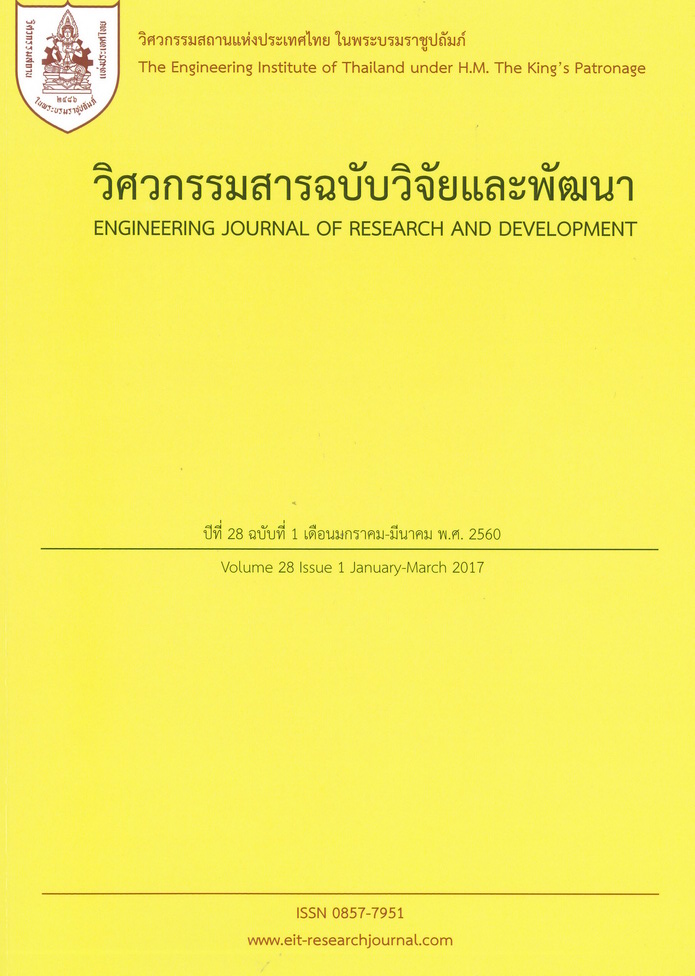SEALING OF SALT AND POTASH MINE USING SUGARCANE BAGASSE ASH MIXTURE
Main Article Content
Abstract
This research investigates the utilization of sugarcane bagasse ash (SCBA) mixed with Portland cement, bentonite and crushed salt as sealing materials to reduce the subsidence in salt and potash mine. The strength and toughness of the mixture are determined here. The ratio of SCBA-to-cement (cementitious materials) is 20:80 by weight and bentonite-to-crushed salt (bentonite crushed salt mixture) is 30:70 by weight. The mixture ratios of cementitious materials to bentonite-crushed salt are 1:2 (CPB-1) and 1:3 (CPB-2). The constant saturated brine-to-mixed materials ratio of 0.4 is used for blending. The uniaxial compressive strength (UCS) test, triaxial compression (TRI) test and Brazilian tensile strength (BZ) test are performed for each curing period of 3, 7, 14 and 28 days. The test results are used in FLAC program to simulate the time dependent behaviors of salt and potash mine with sealing materials. In this study, the UCS and BZ of CPB-1 mixture provides 7 MPa and 1.02 MPa while CPB-2 mixture gives 5 MPa and 0.86 MPa at a curing period of 28 days. The results clearly show that CPB-1 mixture can produce more strength than CPB-2 mixture. The cohesion (c) and internal friction angle (f) are gradually increased at the first two weeks and then tend to remain constant after 28 days. The elastic moduli and Poisson’s ratio are slightly increased. From the numerical analysis, the result obtained from the mine opening with the CPB-2 sealing can reduce the magnitude of subsidence about 46% as compared with that without backfills.
งานวิจัยนี้ศึกษาการใช้เถ้าชานอ้อยเป็นวัสดุทดแทนซีเมนต์เพื่ออุดในช่องเหมืองเกลือและเหมืองโพแทซ โดยส่วนผสมประกอบด้วยเถ้าชานอ้อย ปูนซีเมนต์ปอร์ตแลนด์ เบนโทไนท์และเกลือหินบด การทดสอบกำลังและความแกร่งของวัสดุผสมได้ถูกดำเนินการเพื่อนำมาใช้ในการประเมินประสิทธิภาพการลดขนาดการทรุดตัวของผิวดินในเหมืองเกลือและเหมืองโพแทซ “วัสดุซีเมนต์” ผสมระหว่างเถ้าชานอ้อยกับปูนซีเมนต์ปอร์ตแลนด์ ในอัตราส่วนเท่ากับ 20:80 โดยน้ำหนัก และเบนโทไนท์ผสมเกลือหินบดในอัตราส่วนเท่ากับ 30:70 โดยน้ำหนัก โดยกำหนดให้ส่วนผสมของ “วัสดุซีเมนต์” ต่อ “เบนโทไนท์ผสมเกลือบด” มีอัตราส่วน 1:2 (CPB-1) และ 1:3 (CPB-2) ในการทดสอบใช้สัดส่วนของน้ำเกลือเข้มข้นต่อวัสดุผสมทั้งหมดมีค่าเท่ากับ 0.4 การทดสอบกำลังอัดแกนเดียว (UCS) และกำลังอัดแบบสามแกน (TRI) และการทดสอบกำลังรับแรงดึงแบบบราซิล (BZ) ถูกทดสอบกับตัวอย่างที่ผ่านการบ่มด้วยระยะเวลา 3, 7, 14 และ 28 วัน ผลที่ได้จากการทดสอบถูกนำมาใช้การคำนวณด้วยโปรแกรม FLAC เพื่อจำลองพฤติกรรมในเชิงเวลาของช่องเหมืองในชั้นเกลือและโพแทซที่ถูกอุดด้วยวัสดุผสมนี้ จากผลการทดสอบพบว่าค่ากำลังอัดในแกนเดียวและกำลังดึงแบบบราซิลหลังจากผ่านการบ่มด้วยระยะเวลา 28 วัน สำหรับตัวอย่างที่ผสม “วัสดุซีเมนต์” ต่อ “เบนโทไนท์ผสมเกลือบด” อัตราส่วน 1:2 (CPB-1) มีค่าเท่ากับ 7 MPa และ 1.02 MPa และสำหรับอัตราส่วน 1:3 (CPB-2) มีค่าเท่ากับ 7 MPa และ 1.02 MPa ตามลำดับ ผลระบุว่าส่วนผสม CPB-1 มีกำลังสูงกว่าส่วนผสม CPB-2 ค่าความเค้นยึดติดและมุมเสียดทานภายในของตัวอย่างมีค่าเพิ่มขึ้นในช่วงสองสัปดาห์แรกและมีแนวโน้มคงที่หลังจาก 28 วัน ค่าสัมประสิทธิ์ความยืดหยุ่นและอัตราส่วนปัวซองมีการเพิ่มขึ้นเพียงเล็กน้อย การวิเคราะห์ด้วยแบบจำลองทางคอมพิวเตอร์ที่ใช้ผลการทดสอบของตัวอย่างส่วนผสม CPB-2 พบว่าการทรุดตัวของผิวดินลดลงประมาณ 46% เมื่อเทียบกับกรณีที่ไม่มีการอุดช่องเหมือง
Article Details
The published articles are copyright of the Engineering Journal of Research and Development, The Engineering Institute of Thailand Under H.M. The King's Patronage (EIT).


